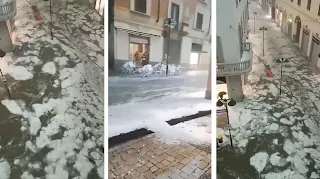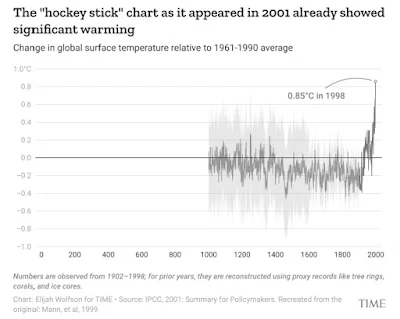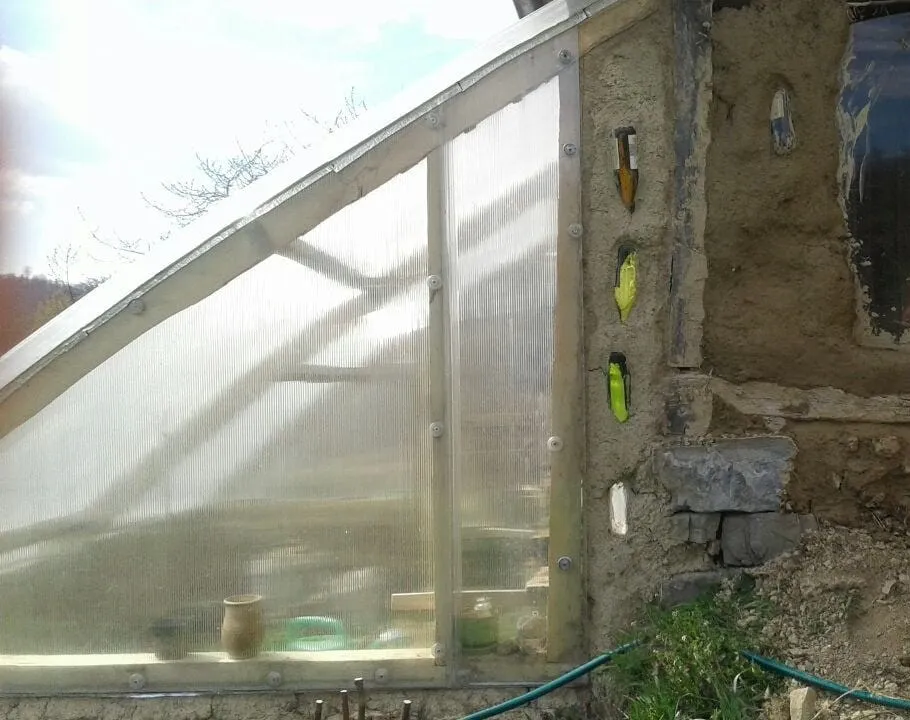Upending the Climate Hockey Stick
"As Rossby waves will eventually extend everywhere, all the time, there is nowhere safe, and nowhere to hide. Migration is futile."
In the 1970s, I had a running debate over peak oil and climate change with a friend who worked at the White House Office of Technology Assessment. It was the consensus view of the Carter Administration that there was no such thing as peak oil because of deep, abiogenic methane, a so-called “natural” gas (note the spectacularly successful P.R. monicker). In their view, gas supplies were virtually infinite.
One climate goal of the Administration, supported by Rocky Mountain Institute, Friends of the Earth, Environmental Defense Fund, and other Carter insiders, became the transition from coal to gas. The National Labs ramped up research that led to fracking for “unconventional” fuels, a.k.a. methane. Within a few years, the global warming impact of fugitive methane from fracking in the U.S. exceeded that of all U.S. coal-fired power plants. Mission accomplished.
This essay could be about misplaced government priorities but let’s save that for another day.Since peak oil was unlikely to curb climate change (a view ridiculed by the Association for Peak Oil, among others) the Carter Administration went all in on gas production while leveraging its future on fireside chats with the President in a cardigan sweater urging people to consume less and turn the thermostat down in winter. Ronald Reagan’s Morning in America mopped the floor with that jive. “You can never get elected promising people less,” Bill Clinton famously remarked.
Seventy-seven percent had a favorable view of natural gas, far higher than when asked about their views on methane. Less than a third were able to link that natural gas is primarily methane. In the same poll, a majority incorrectly answered that they think methane pollution is declining or staying about the same.
—Vox (2023)
As late as the 1980s, the dominant view was that we could see one degree of warming by 2100. Then came Michael E. Mann’s “hockey stick” chart:
Here is a 2023 update:
The Hockey Stick concept was an eye-opener because it demonstrated we were not on a one-degree-per-century trajectory as had been forecast. If you took a protractor and applied it to the slope after the Kyoto Protocol in the 1990s it is nearly 90 degrees straight up—an exponential singularity.
What had seemed to be the stick—the 800,000-year ice record of the stable Holocene—was actually the blade. The Anthropocene—rising nearly without pause since 1970—is the stick.
As we look at charts of this year’s changes, it is obvious that Mann was not entirely wrong, just overly conservative (as befits someone in his position). To his credit, he was soon thereafter to endure the brunt of charges of scientific fraud coming from Jim Inhofe, a U.S. Senator who calls the science of man-made climate change a hoax. He was sued by the Attorney General of Virginia and right-wing astroturf think tanks, and he displayed great courage and character in how he fought back. His books, The Hockey Stick and the Climate Wars, The Madhouse Effect: How Climate Change Denial Is Threatening Our Planet, Destroying Our Politics, and Driving Us Crazy, The New Climate War: The Fight to Take Back Our Planet, and Our Fragile Moment: How Lessons from Earth's Past Can Help Us Survive the Climate Crisis are must reads.
When I was writing Climate in Crisis in the 1980s I mused that perhaps Tennessee was not the best place to live. Might it not be better to uproot my family—or even my village—I asked, and migrate poleward like red maple, armadillos, and malaria? Maybe we’d be better off on Cape Breton Island in Nova Scotia, Cortes Island in British Columbia, or Connemara, County Galway Ireland.
Then came the Rossby Waves.
Rossbymania
Rossby’s marching orders were in his fellowship contract: "to study the application of the polar front theory to American weather.” Eventually, that effort would make him the first meteorologist to grace the cover of Time magazine.
Atmospheric Rossby waves on Earth are giant meanders in high-altitude winds that have a major influence on weather. These waves are associated with pressure systems and the jet stream (especially around the polar vortices). Oceanic Rossby waves move along the thermocline: the boundary between the warm upper layer and the cold deeper part of the ocean.
A normal circumpolar jet stream would be nearly linear, as it has mostly been for the past tens of thousands of years, allowing human civilizations to rise and flourish.
When Northern Hemisphere ice melts and the Arctic Ocean warms, owing now entirely to human-induced climate change, the jet stream slows and meanders. It can even stall over some regions for days or weeks, as we are watching while I write this.
 |
The late July hailstorms and flooding in Seregno, northern Italy, have gone viral on social media, showing rapid floods engulfing the small streets, with sheets of ice forming on balconies, and miniature icebergs flowing through the streets, knocking into cars. Winds of 140 mph were reported in Veneto. Last year, the Tour de France was briefly delayed while snow was cleared from the roads. In July.
Only a little farther to the Southeast, on the other side of the wave, Greek islands are evacuating residents who are in the path of unprecedented wildfires brought on by the exceptional heat. To the West, Spain was experiencing heat extremes that make the Sahara Desert seem balmy by comparison.
This is just the start
This is just the start. We recently exited an unusually long La Niña cycle, with a cooler Pacific Ocean, and are in the transition phase before the next El Niño as the global ocean rapidly warms. Water temperatures today in parts of the Gulf of Mexico and the Caribbean were 100°F. (37.8°C) Next year, when El Niño really arrives, it should be much warmer.
Let me pause here, dear reader, and commiserate with you about this deluge of doomer porn. Hang in there because there is method in my madness. Einstein is quoted as having said, “If I had an hour to solve a problem I'd spend 55 minutes thinking about the problem and five minutes thinking about solutions.” We will return to solutions, but we need to lay out the problem first.
 |
The world is now, on average, between 1.2 and 1.4°C warmer than it was before humans started thickening the glass in the greenhouse to hold in more heat. Predictions for the year 2100, on our present path, are 3.4-3.7°C warmer. Given what we have seen, that is likely an underestimate.
The World Weather Attribution team estimated that rising greenhouse gas concentrations made the European heatwave 2.5 Celsius (4.5 Fahrenheit) hotter than it would otherwise have been. They also drove up the North American heatwave by 2°C and the one in China by 1°C.
—Reuters 7/25/23
Where to Go?
Going back to my middle age mulling about where to relocate, it is obvious to me now that Canada or Ireland are not any safer than Tennessee. At the end of June, 2021, Lytton, British Columbia posted 49.6°C (121°F), higher than the all-time records for Europe and South America. The next day (June 30), a wildfire swept through the valley and 90 percent of the village burned down. Daily highs were set as far east as Newfoundland and Labrador. Happy Valley-Goose Bay reached 33.2°C (91.8°F). Seattle hit 108°F. In Vancouver’s intertidal zone, temperatures reached up to 122°F (50°C) and more than a billion seashore animals, like clams, barnacles and oysters, died. In Seattle, nearly a hundred juvenile terns, whose nests were on top of an industrial building, died when they plunged to the pavement below, presumably trying to escape the heat. Those that survived were treated for burns. Seven people died and 85 were hospitalized in Phoenix last week simply from burns from touching the pavement.
In 2021, smoke from Siberian fires had covered the North Pole. This year it leapt over it. There were 377 active wildfires in British Columbia as of July 15. Nova Scotia saw the largest number of recorded wildfires in its history. On June 28, the air quality in Toronto ranked among the worst in the world. Because of that smoke, New York City public high schools and the School District of Philadelphia switched to virtual learning. Then Chicago got the top spot for worst air quality in the world.
Tracking Rossby wave domes around the Northern Hemisphere summer in 2023:
Sardinia 47°C (116.6°F)
Palermo 47°C (116.6°F)
Rome 41.8°C (107.2°F)
Athens 41°C (105.8°F)
Santorini 41°C (105.8°F)
Seville 41°C (105.8°F)
Tozeur, Tunisia 46.9°C (116.4°F)
Chlef, Algeria 47.4°C (117°F)
Faya, Chad 45.8°C (114°F)
Kharga, Egypt 45.2°C (113°F)
Bilma, Niger 44.4°C (112°F)
Israel 45°C (113°F)
Saudi Arabia 50.5°C (123°F)
Turkmenistan 42°C (107.6 F)
Uzbekistan 43°C (109.4 F)
Kazakhstan 41°C (105.8 F)
China 52.2°C (126.0°F)
United States 53.9°C (129°F) (same day as for China)
Yekaterinburg Russia (56°N) 40°C (104°F)
Puerto Rico 52°C (125°F)
Mexico 49°C (120°F)
Lytton, BC 46.9°C (116.4°F)

 |
coal company advertises a “layer cake filled with ‘buried sunshine.’” Provided by Alan Levinovitz |
Barbenheimer
Last Friday I went to the first local showing of Oppenheimer. What came to my thoughts was how much we take it for granted these days that even the most gargantuan problems can be solved. We saw a problem, we threw a lot of money at it. We solved it. Same for landing a man on the moon, or eliminating polio and smallpox. We think that will work for climate change. In Paris in 2015 the term was “trillionization.” Leave it to the scientists and industrialists. Give them unlimited money. They will invent carbon dioxide removal machines to save us.
But what if they don’t? What if they can’t? What if the story we have been telling ourselves—technologie über alles—is a fairy tale? When we discover that, what will we do then? Will we have enough time?
We like to declare weather emergencies. Then we throw money at rescues, repairs, and clean-ups. We’ve yet to declare a climate emergency. Why is that? Is it not hot enough for us yet?
References
Buck, Holly Jean. Ending fossil fuels: Why net zero is not enough. Verso Books, 2021.
Buck, Holly Jean. Who Authors Future Environments? Public engagement with emerging environmental technologies in the Anthropocene. Diss. Doctoral dissertation. Cornell University, 2017.
Fuhrman, Jay, et al. "Diverse carbon dioxide removal approaches could reduce impacts on the energy–water–land system." Nature Climate Change 13.4 (2023): 341-350.
Lacroix, Karine, et al. "Different names for “natural gas” influence public perception of it." Journal of Environmental Psychology 77 (2021): 101671.
Meanwhile, let’s end this war. Towns, villages, and cities in Ukraine are being bombed every day. Ecovillages and permaculture farms have organized something like an underground railroad to shelter families fleeing the cities, either on a long-term basis or temporarily, as people wait for the best moments to cross the border to a safer place or to return to their homes if that becomes possible. There are 70 sites in Ukraine and 500 around the region. As you read this, 24 Ukrainian ecovillages have given shelter to more than 2500 people (up to 500 children) and now host up to 1400 persons (around 200 children). We call our project “The Green Road.”
For most of the children refugees, this will be their first experience in ecovillage living. They will directly experience its wonders, skills, and safety. They may never want to go back. Those that do will carry the seeds within them of the better world they glimpsed through the eyes of a child.
Those wishing to make a tax-deductible gift can do so through Global Village Institute by going to http://PayPal.me/greenroad2022 or by directing donations to greenroad@thefarm.org.
There is more info on the Global Village Institute website at https://www.gvix.org/greenroad or you can listen to this NPR Podcast and read this recent article in Mother Jones. Thank you for your help.
The COVID-19 pandemic destroyed lives, livelihoods, and economies. But it has not slowed climate change, a juggernaut threat to all life, humans included. We had a trial run at emergency problem-solving on a global scale with COVID — and we failed. 6.88 million people, and counting, have died. We ignored well-laid plans to isolate and contact trace early cases; overloaded our ICUs; parked morgue trucks on the streets; incinerated bodies until the smoke obscured our cities as much as the raging wildfires. The modern world took a masterclass in how abysmally, unbelievably, shockingly bad we could fail, despite our amazing science, vast wealth, and singular talents as a species.
Having failed so dramatically, so convincingly, with such breathtaking ineptitude, do we imagine we will now do better with climate? Having demonstrated such extreme disorientation in the face of a few simple strands of RNA, do we imagine we can call upon some magic power that will arrest all our planetary-ecosystem-destroying activities?
As the world emerges into pandemic recovery (maybe), there is growing recognition that we must learn to do better. We must chart a pathway to a new carbon economy that goes beyond zero emissions and runs the industrial carbon cycle backward — taking CO2 from the atmosphere and ocean, turning it into coal and oil, and burying it in the ground. The triple bottom line of this new economy is antifragility, regeneration, and resilience. We must lead by good examples; carrots, not sticks; ecovillages, not carbon indulgences. We must attract a broad swath of people to this work by honoring it, rewarding it, and making it fun. That is our challenge now.
Help me get my blog posted every week. All Patreon donations and Blogger or Substack subscriptions are needed and welcomed. You are how we make this happen. Your contributions are being made to Global Village Institute, a tax-deductible 501(c)(3) charity. PowerUp! donors on Patreon get an autographed book off each first press run. Please help if you can.
Thank you for reading The Great Change.

















Comments